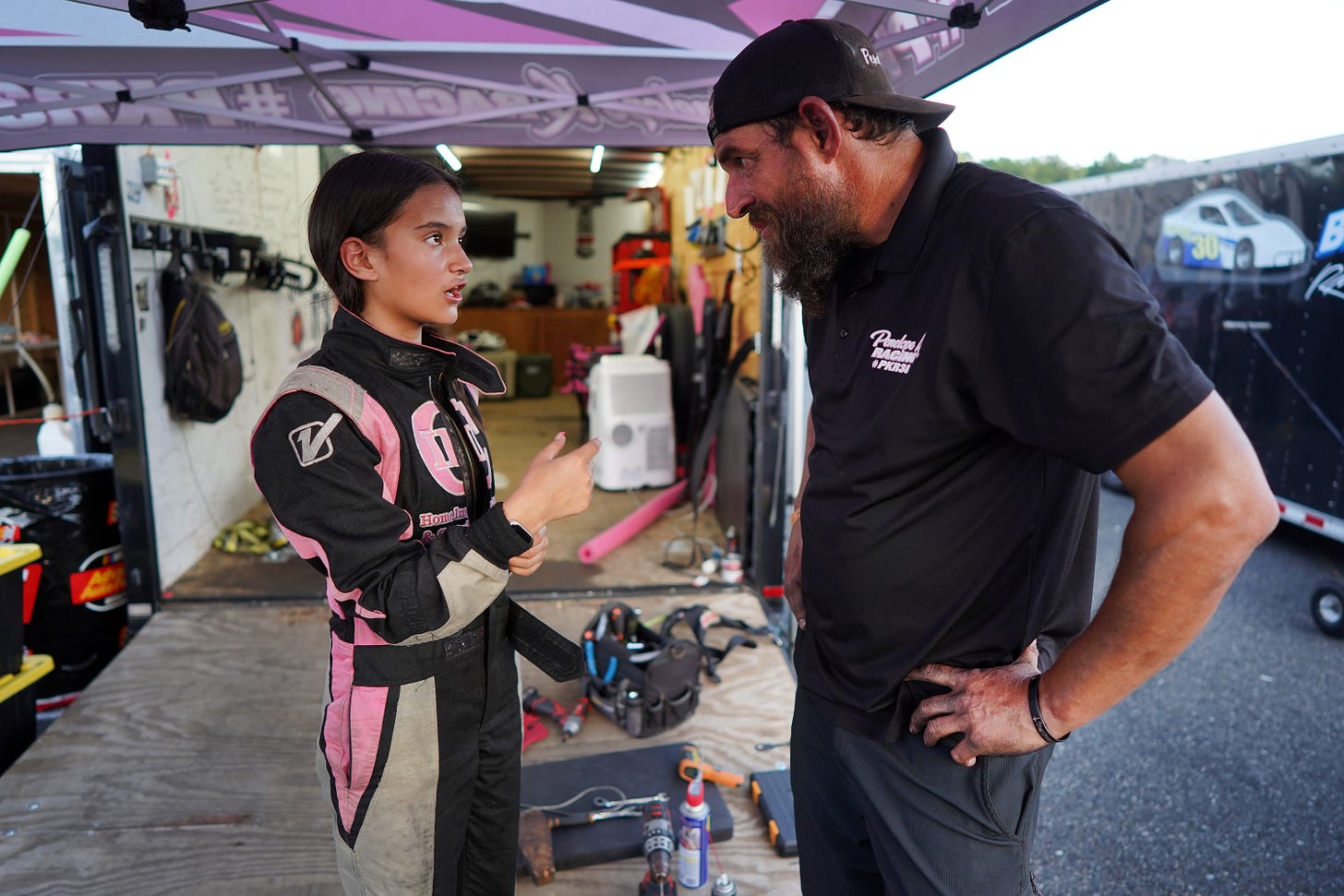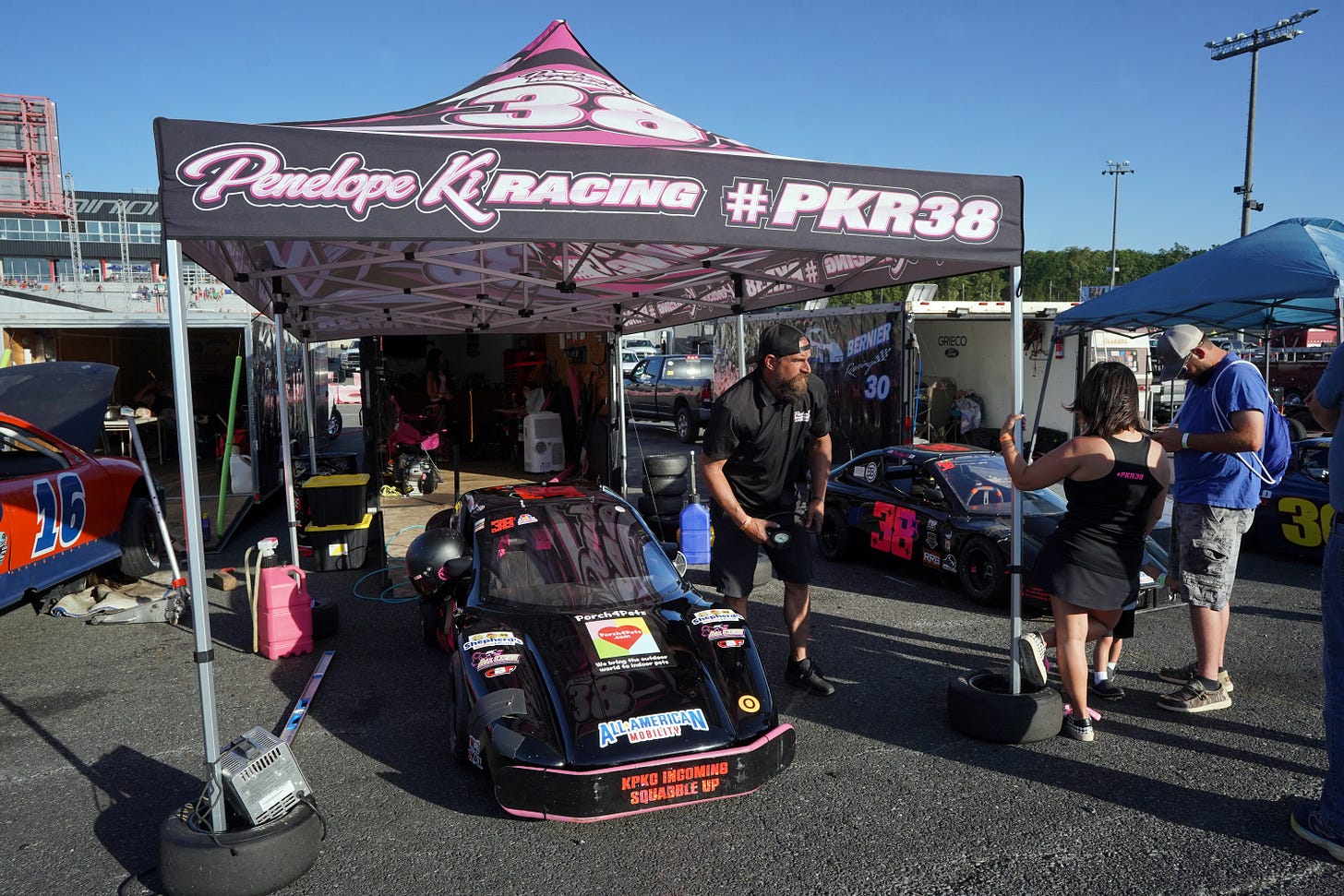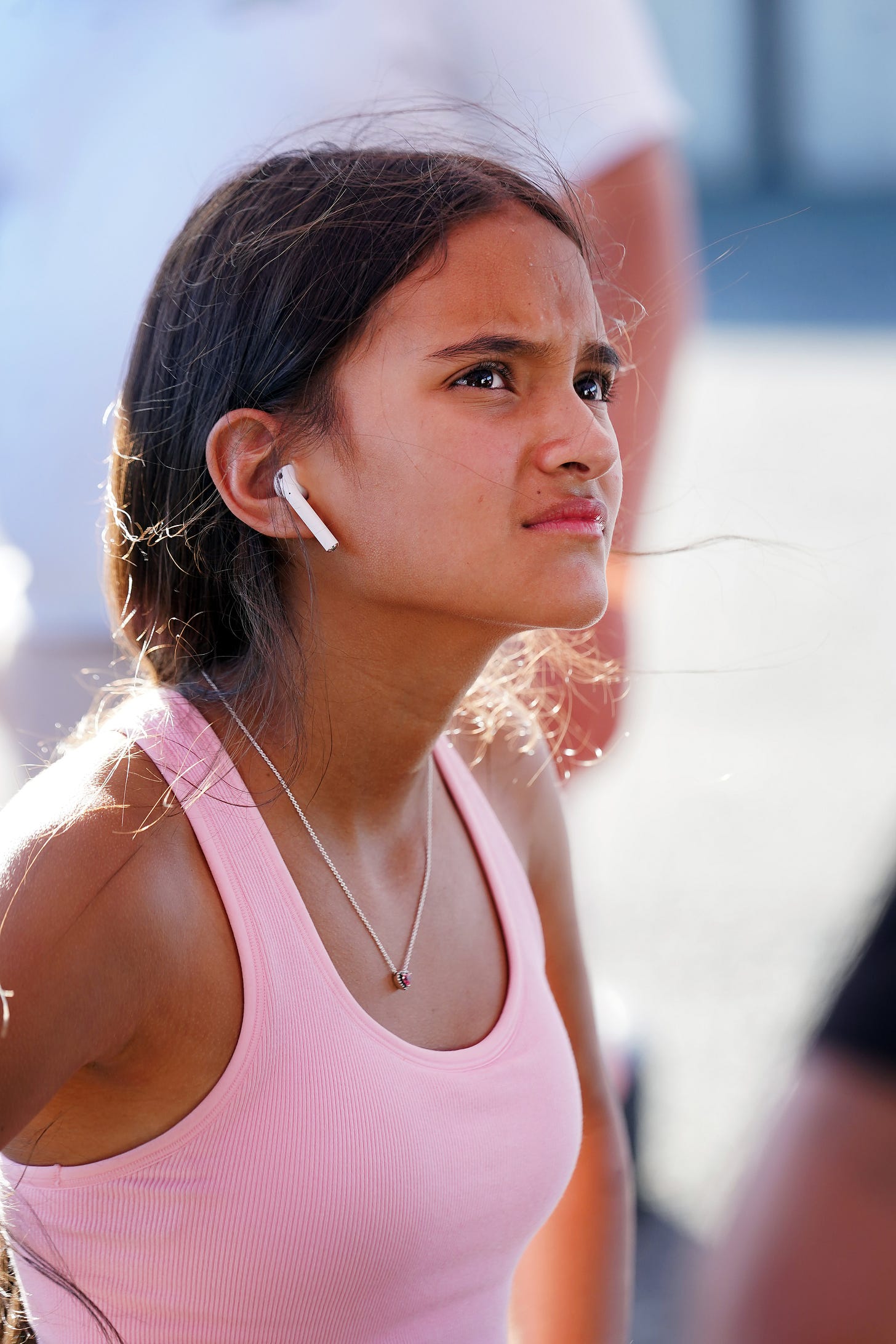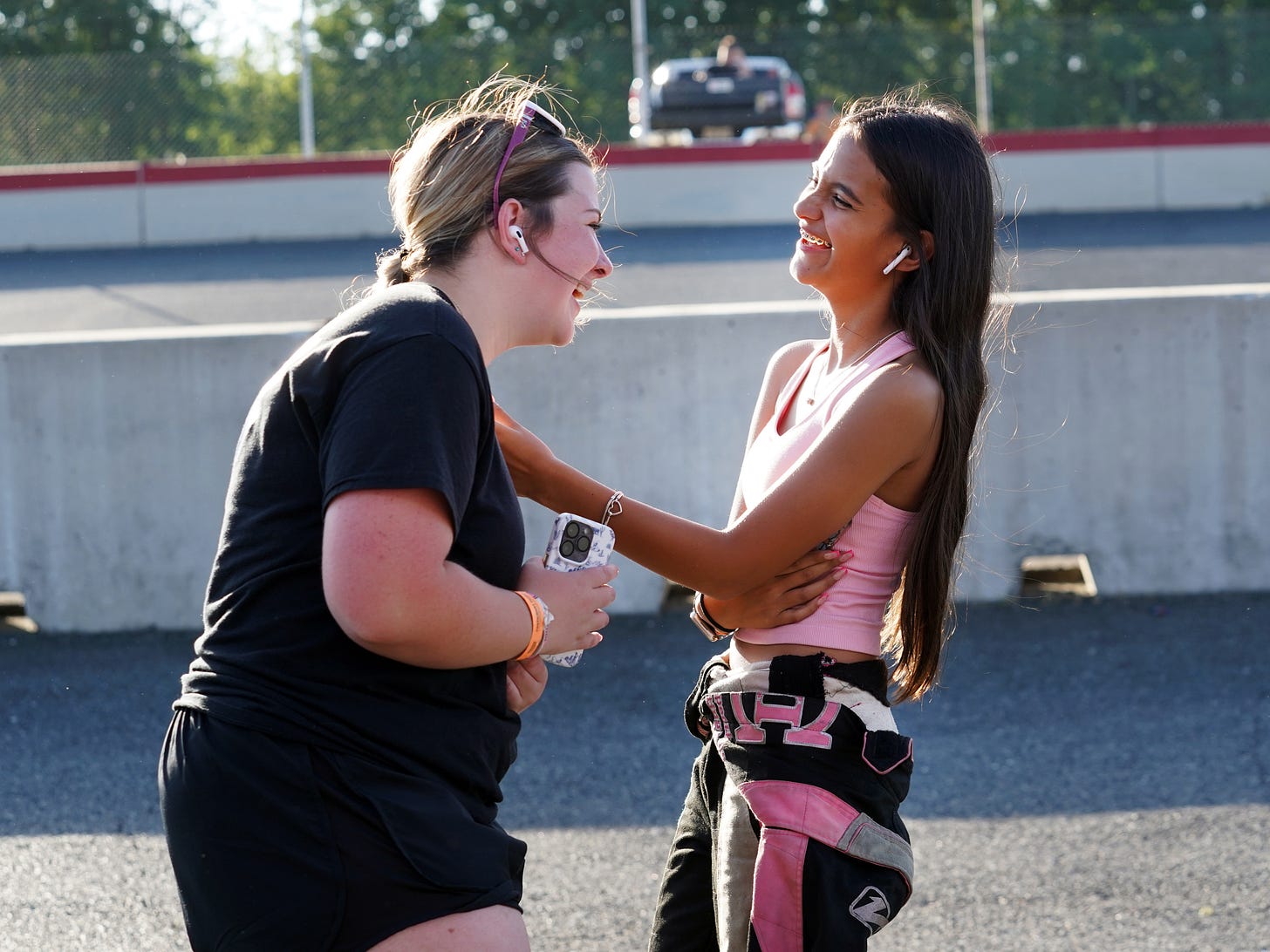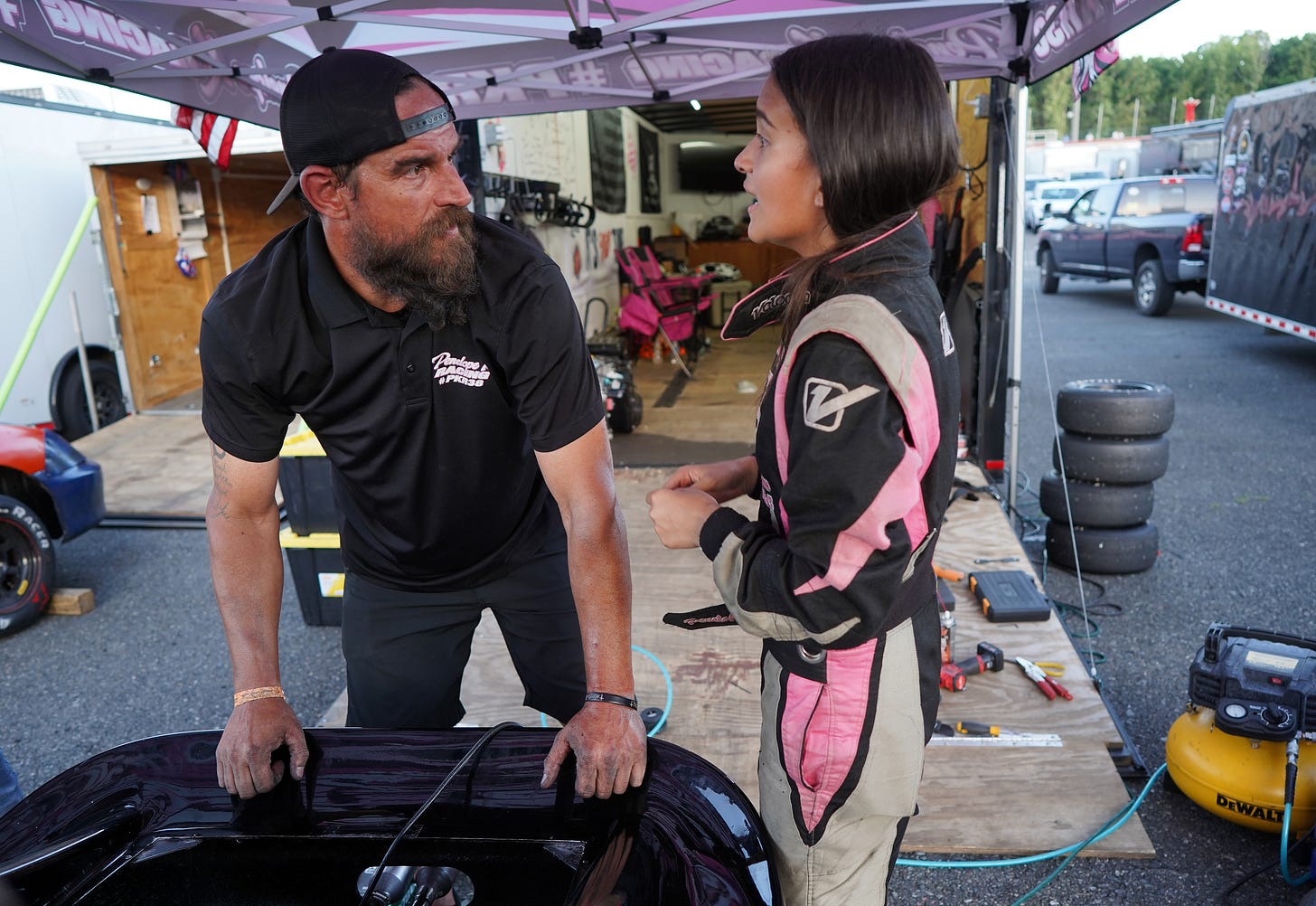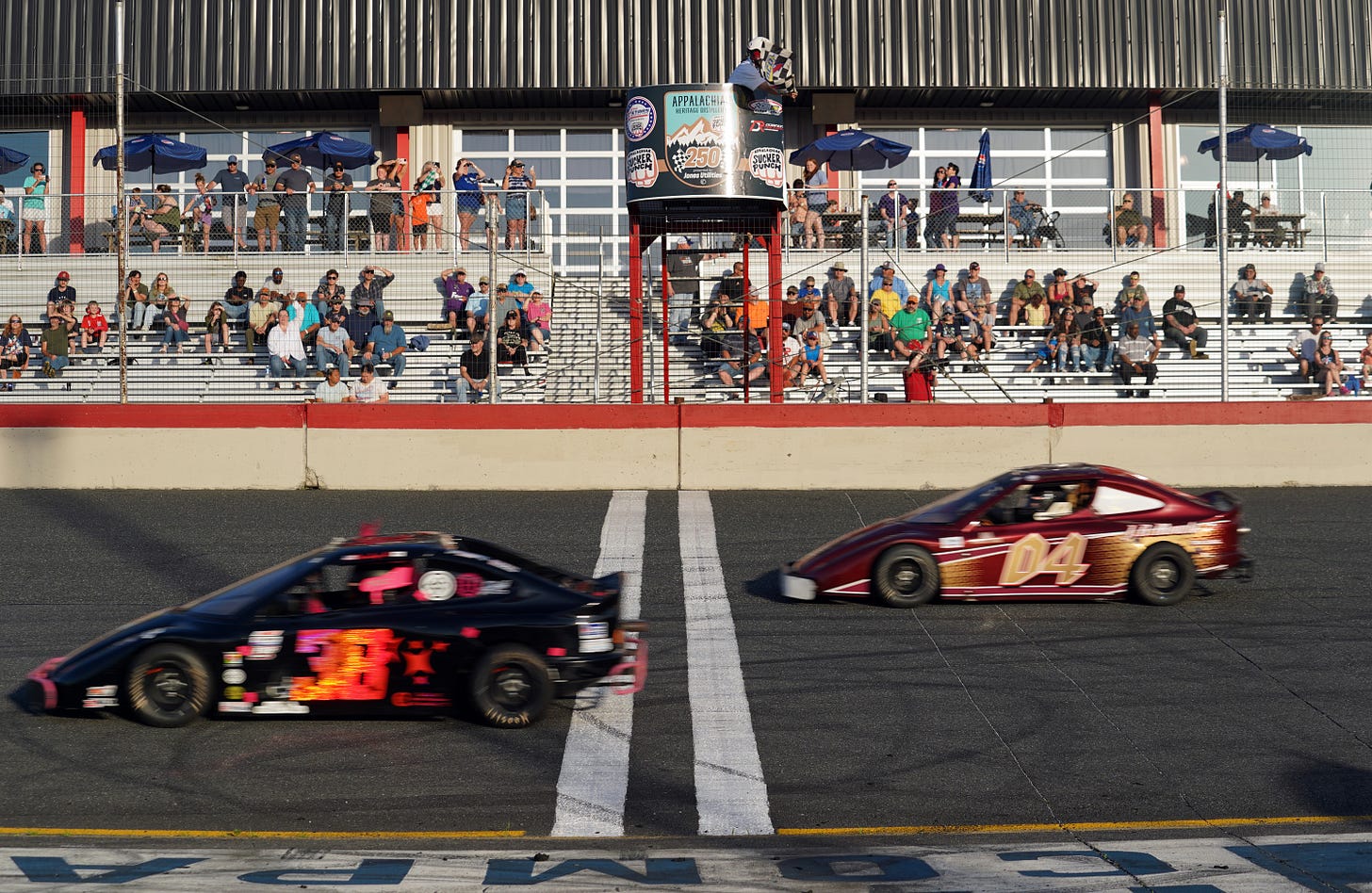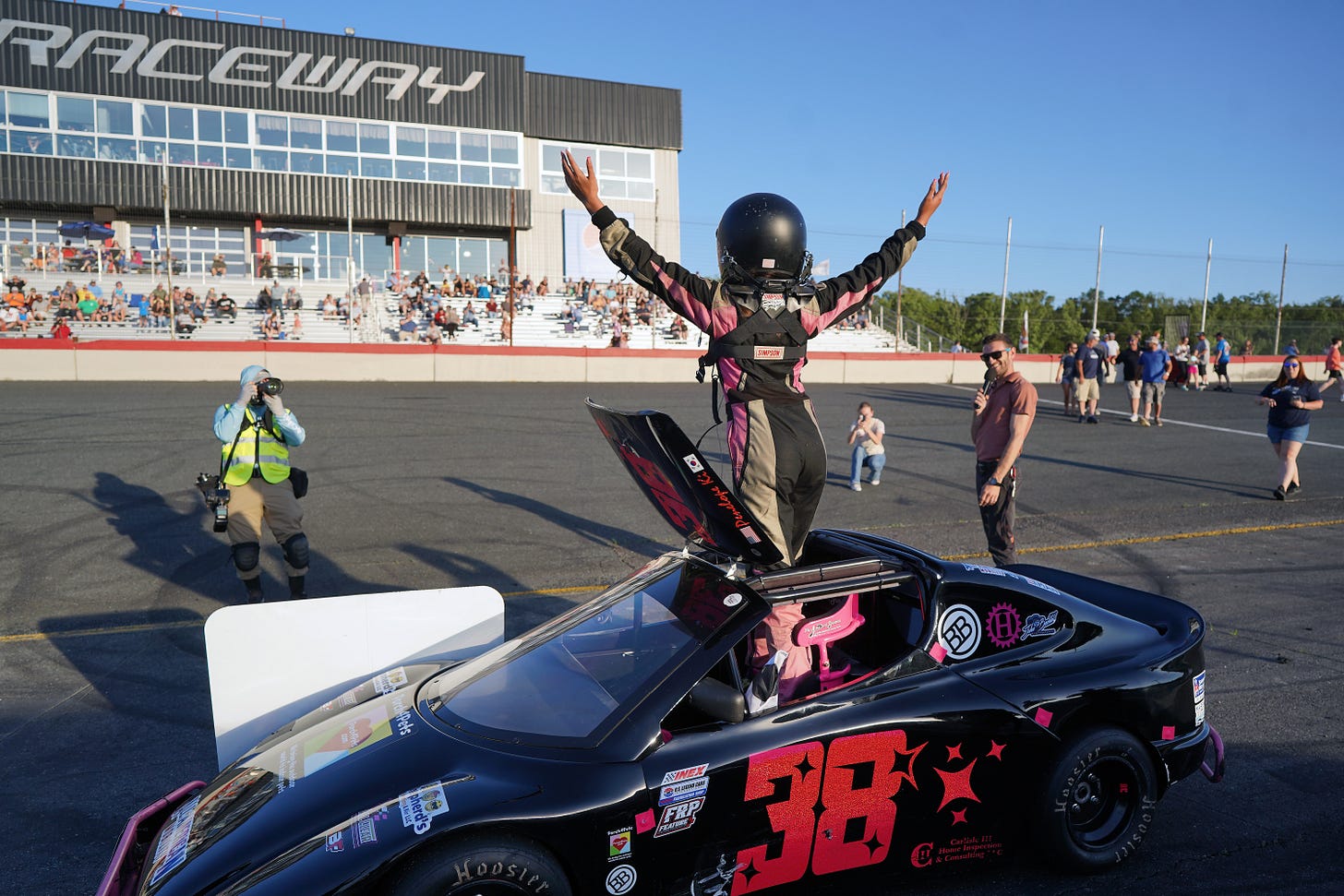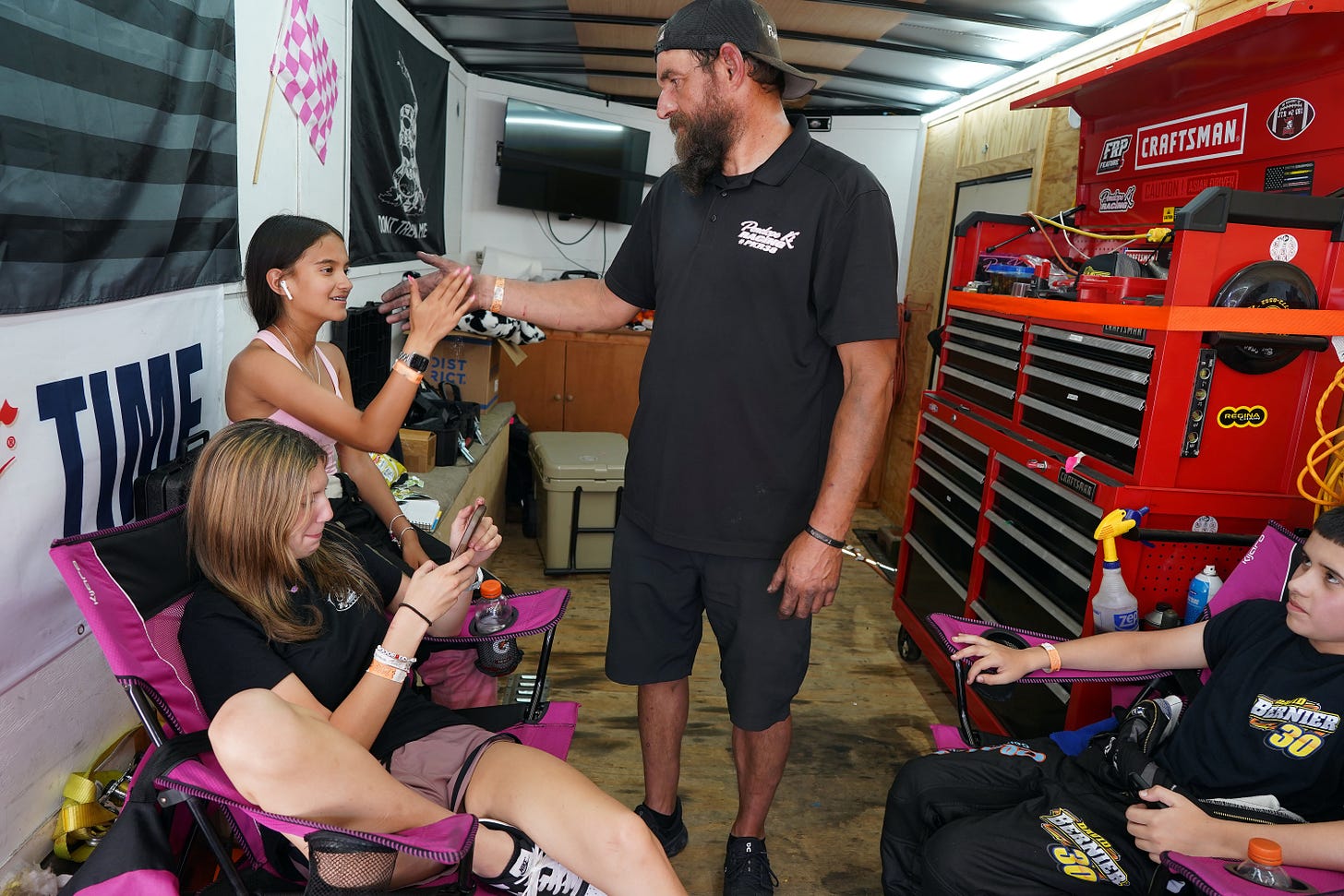Fire in the Eyes
When her father, Justin, says "10 minutes," 13-year-old Penelope transforms from carefree to laser-focused. Everything one needs to know about her commitment to racing is in her eyes.
Story by Martin Davis
EDITOR-IN-CHIEF
Email Martin
Photos by Suzanne Rossi
Well before noon on a recent Saturday, the pits at Dominion Raceway were already filled with trucks, their trailers, and the cars that racers from across the East Coast bring to test their mettle on the track’s 4/10’s mile oval.
Racing doesn’t start until late that evening, but testing begins at 1:30. Already, the weather is a factor.
Outside the raceway the air is warm. It’s tempered, however, by a steady, cooling breeze. Inside the raceway and down in the pits, the track’s high walls keep the breeze at bay, turning the roadway into a heat-radiating bowl — every rising degree being monitored by drivers and their teams.
Inside the black and pink trailer of car No. 38, 13-year-old Spotsylvania native Penelope Carlisle; her mother, Diane; and two slightly older teenage girls — Rhylee and Kaitlyn — are sitting in the shade, chatting, and pulling drinks from the cooler to quinch their thirsts.
Outside the trailer, Justin Carlisle — Penelope’s father — is leaned over the No. 38 car, checking tire pressures, and running through a checklist that over three years he’s come to know by heart.
As Justin finishes his checks, he steps inside the trailer, grabs a water, sits down, and catches his breath.
“We don’t take vacations,” he told the Advance. “We take race-cations.”
Penelope has been racing Bandoleros — a small version of a NASCAR-type race car — for three years. Though she’s always had all-terrain vehicles and go-carts at the house to drive, Justin said she quickly grew bored.
“She said they weren’t fast enough.”
Following a bit of research, Justin learned about Bandolero cars, which can top 90 mph without restrictor plates, and about 72 - 73 mph with them. Penelope was onboard, and soon she was taking her first steps toward becoming a driver.
Most every weekend since she started racing, the family has spent time in pits from Florida, through the Carolinas, and up to Massachusetts as Penelope works toward her goal — NASCAR.
Ten Minutes!
Refreshed, Justin turns and looks to the back of the trailer — “10 minutes,” he called out.
Penelope almost immediately went inside herself and conjured a new personality.
Were her change a transmission, the instant shift in demeanor would have stripped her gears. The laughs and the giggling and the jokes were gone, replaced in a single heartbeat by pre-race music streaming through the AirPods she inserted into her ears; pulling on her fire suit; and sitting alone, thinking, about the task ahead.
This is true of any race driver preparing to run, of course. What sets Penelope apart are her eyes. They narrow, sharpen, and shut out all but the things that matter at that moment. And that look will not change until she comes off the track and climbs out of the No. 38.
There are precious few athletes whose eyes are as telling as Penelope’s. The great Chicago Bears linebacker Mike Singletary was well-known for his “linebacker eyes.” Michael Jordan of the Chicago Bulls was also renowned for his stare.
Call it an intangible. It can’t be captured in a stat line or quantified with analytics. But to everyone who sees it, they know what it means. It will take their very best to run with her that day, and even that most likely won’t be enough.
1:45 P.M.
Climbing into her car, Penelope straps into the five-point harness, the HANS safety device, and stares coldly ahead.
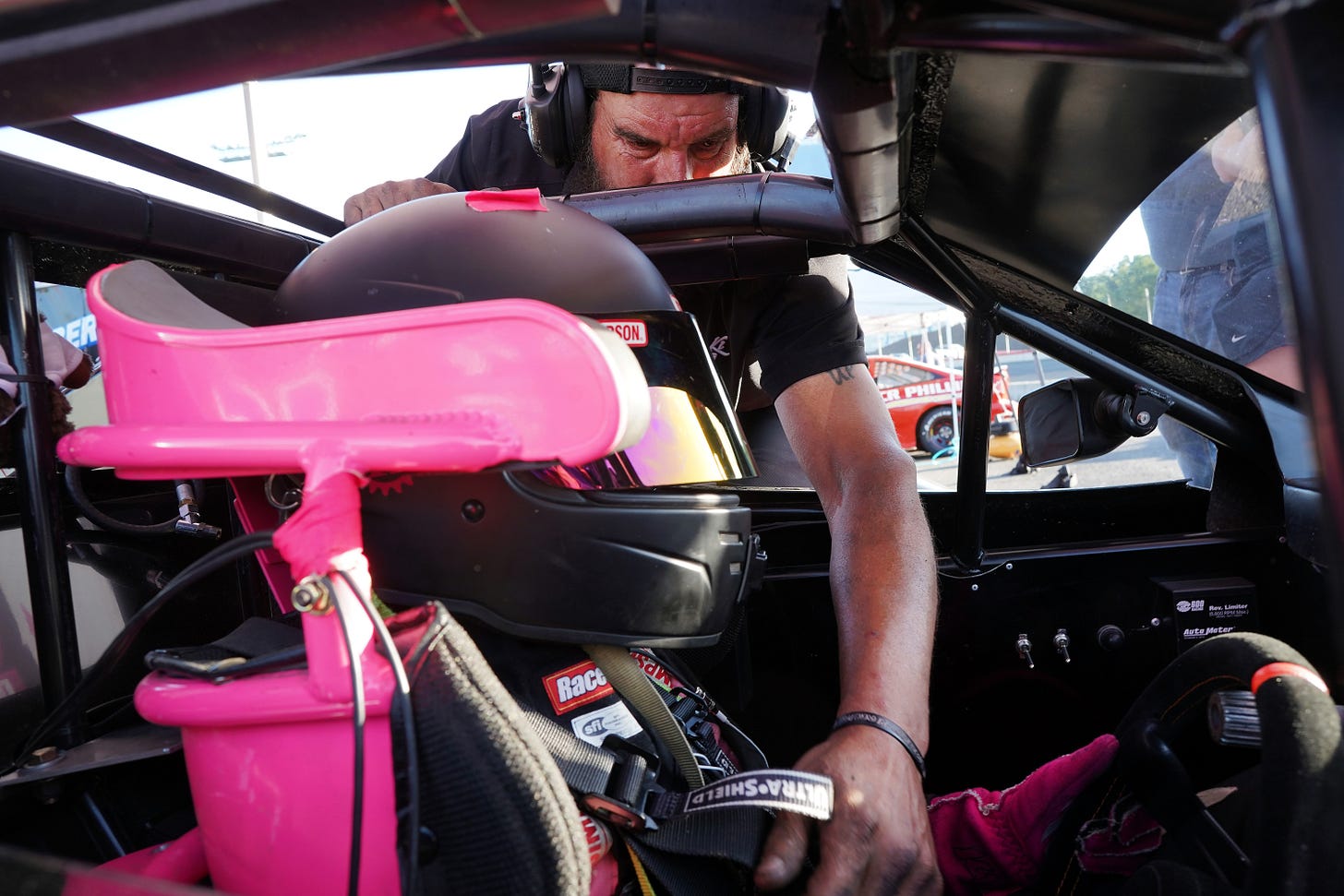
A final conversation and check with Justin, and Penelope rolls the No. 38 onto the roadway inside the pit and makes her way to the track for her practice run.
Justin will move to the start-finish line, connected by radio with Penelope and her spotter.
Diane takes her normal position at Dominion Raceway — along the retaining wall opposite her husband on the backstraight between turns two and three.
In her hand she holds her phone that has an app displaying in real-time Penelope’s lap times.
When Penelope passes Diane the first time, Diane raises her fist in encouragement, then looks down for the time. Seconds later, 20.076 pops up on the screen. Diane yells; Penelope is a full two-tenths of a second faster than her closest competitor.
After each lap, she checks her phone. Penelope’s lap times vary by only a few hundredths of a second. She’s not only fast, she’s consistent.
During time trials, there is no drafting allowed, so as Penelope approaches the car in front of her on the backstretch, she moves outside, and then, just as she moves into turn three, she hears her spotter yell “Clear, clear,” and promptly drops the No. 38 in front of her competitor, just inches from his bumper.
Diane, pumps her fists, lets out a yell, knowing that P Ki, as they sometimes call Penelope, has everything working right this day.
Arriving back in the pits, Ki comes out of the car, gets a hug from her mom, lowers her fire suit, and the narrowness in her eyes gives way to her usual wide-eyed sparkle.
There with her friend Kaitlyn Stradley, a 15-year-old from Wilmington, Delaware, who drives the next class of car up from Bandoleros and is also competing that day, Ki relaxes, laughs and enjoys a few moments of teenaged normalcy.
The down time is not just refreshing, it’s necessary.
The moments on the track are intense. Over the course of her career, P Ki has rolled, been t-boned, crashed into walls, and struggled with being lapped.
“It’s taken 100 races over two years for Ki to get where she’s at,” says Justin. It’s been a “long time coming.”
Early in her career, Penelope was frequently lapped as she wrestled with the reality of running 70-plus mph in a crowd of aggressive racers.
Justin said that over those two years, they set small goals. First, it was just staying on the lead lap. Then, it was running in the middle of the pack. These days, it’s grabbing the pole position and running from the front.
4:00 P.M.
Qualifying is just an hour away. Penelope has been relaxing, but also talking with her dad about the technicalities of the practice laps. She expressed some concern that the car might be too loose. In layman’s terms, when the car turns, the rear end loses traction and has a tendency to slide out.
At 4:05 all the drivers for the evening go to the restaurant inside the raceway for the driver’s meeting. A track official goes over the rules for the day — for example, when the caution flag comes out, how many laps under caution count toward the race — and drivers then make their way back to the pit area.
Penelope has precious little time to lose. Qualifying for the Bandoleros begins at 5:00.
As quickly as Penelope’s eyes went from focused to relaxed, they were again back to focused as she and her father prepared the car for qualifying.
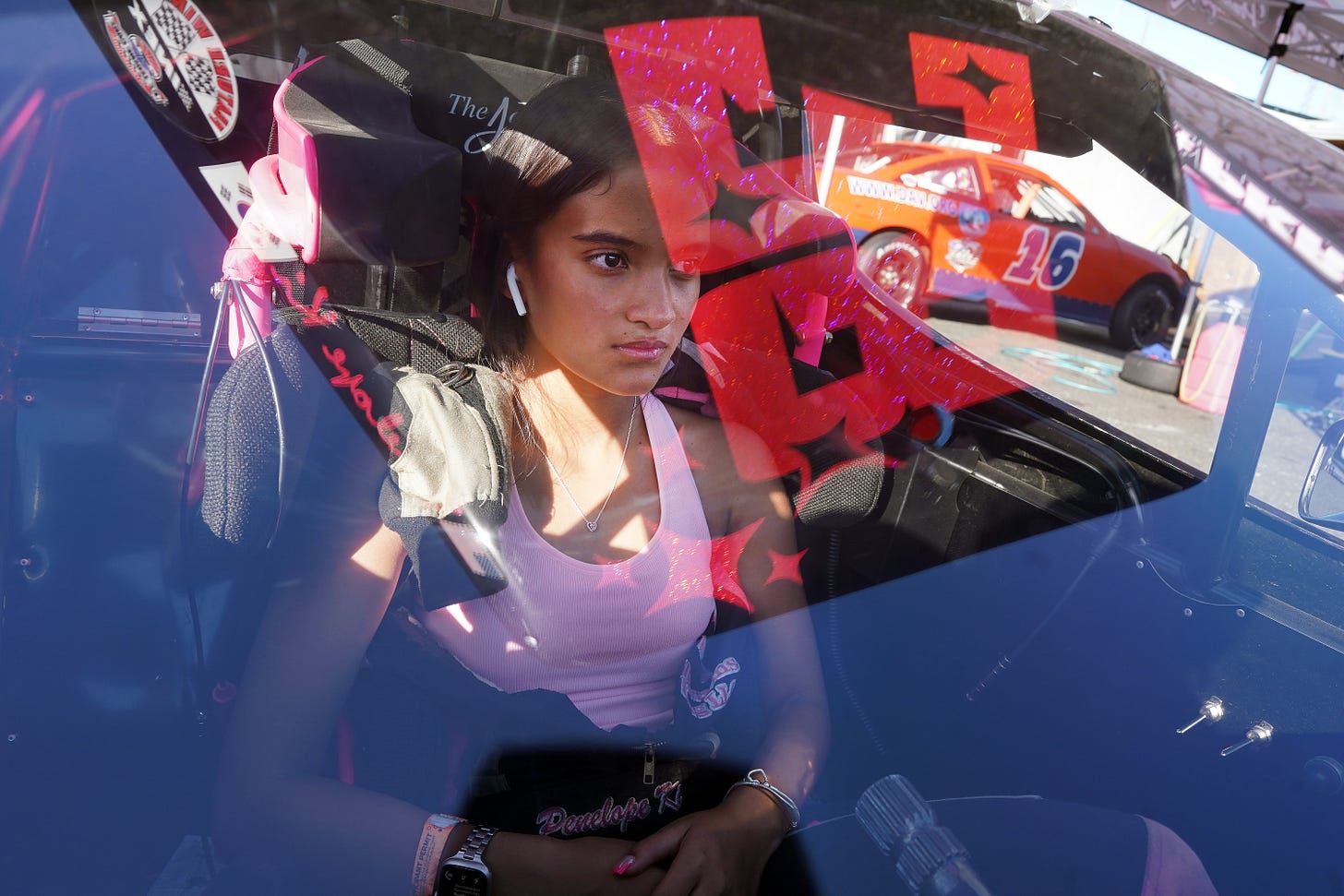
Her smile, which is effervescent, is gone. Bando races are relatively short — 15 laps at Dominion Raceway — so starting on the pole is important. Too far back in the pack, and there is precious little time to move up the leader board.
Justin again calls 10 minutes. The AirPods go in, the fire suit comes up, and Penelope prepares to run for the pole position.
She was the fastest car in practice, but adjustments are constantly being made. Plus, track conditions change quickly. Justin has a thermal reader to check the track temperature. For qualifying, the temperature was running about 15 degrees hotter than during practice.
Justin and Penelope debate adjustments that would tighten the car. After about 10 minutes of back-and-forth discussion, they decide that with how well the car was running, it was best to simply let it stand.
As Penelope rolls onto the track, Justin and Diane retake their places. Now, it’s all up to P Ki.
She does not disappoint. With lap times matching her practice run times, Penelope is a full two-tenths of a second faster than the next car, earning her the spot on the pole.
A great start, but hardly the end of the day.
Running around a track when cars around you aren’t allowed to draft affords a driver the opportunity to focus exclusively on their lines and driving with the pedal down.
Racing against competitors is a more challenging, and much more dangerous, proposition.
6:00 P.M.
As the pre-race ceremonies near, the tension in the pits again rises.
The Bandoleros will be the first to race. Justin and Ki move to their pole position behind the pace car and await the start of the race.
Diane takes up her usual spot at the wall on the back straight.
“The first lap is the hardest,” she said. “No mom can stand the first lap.” In her words, it can be a wreck fest.
On this night, Diane’s fears become reality in short order.
As the pace car leads the cars around, drivers weave to warm their tires. As they come around for the start, Ki is locked into her position.
As the pace car drops off the track, the car on Ki’s outside makes a move and they cross the start-finish line with Ki in second place. As they enter the first turn, the outside car suddenly drops down on Ki, clipping her and forcing her sideways.
Penelope, however, maintains control, holds her line, and from a cloud of white and black smoke the pink 38 car breaks through, back in the race. A wreck behind the pole sitter, however, brings out the yellow flag.
When the car came down on Ki, she let it be known to her spotter that she was upset. Justin later told the Advance that the spotter calmed her down and got her head back in the game.
A good thing, for when the green flag dropped, Penelope took the lead, as the No. 4 car slid in behind her, not more than 6 inches from her rear bumper.
Following a practice run, the Advance asked Penelope if she’s ever distracted by those around her.
“All I see,” she said, “is track.”
While that was certainly true, it’s also true that P Ki could feel the No. 4 car pushing her, positioning himself to make a pass.
“It’s nerve wracking,” Penelope later told the Advance. “You just have to keep your focus.”
So did the No. 4 car, which never was more than a few inches from Ki. But when the checkered flag dropped, it was Penelope out front.
It’s not the first time that Penelope has been cut off by a driver the way she was cut off on the first lap that day. In fact, it wasn’t even the first time that particular driver had cut her off that way.
After collecting the trophy for her win and getting back into the pits, the driver who cut her off came over and apologized. As did the driver’s team leader.
“It’s OK,” Diane said.
It was a kind response to a move that had damaged Penelope’s car.
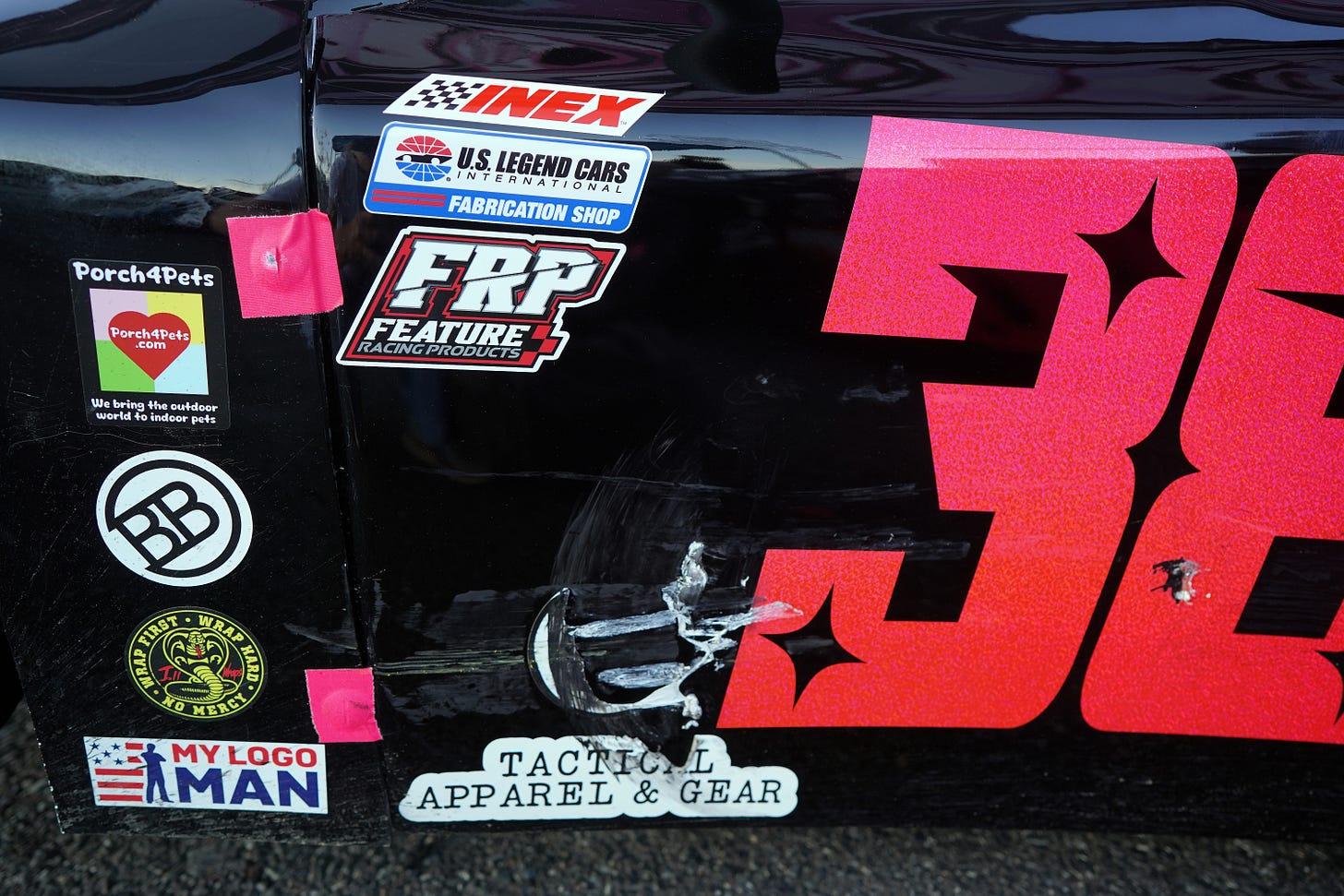
The exterior damage was significant, throwing off the car’s alignment. But that was secondary to what happened to the tire.
The spindle, a small metal knob, was literally pushed into her tire. Penelope ran the race with a tire being rubbed by a piece of metal that made handling the car even more challenging than it already is.
“The girl can drive,” Justin said with a smile.
Tight Knit
Diane said that families on this circuit take care of one another. They’re all competitors, and on the track, it shows.
But, said the mother of a young race driver from Massachusetts who came by postrace to be with Penelope, “they’re still kids. We all try and remember that.”
Not all nine drivers that day follow the 9-month-long race season the way Penelope and the No. 4 car — Ki’s closest competitor — do. Most will race a few weekends locally and never make the trips further south or north.
Money is a big part of the reason.
Kaitlyn, like Penelope, is a highly competitive driver, but in the class that she races — legend cars, which are replicas of a 1934 Chevy or Ford coupe — she is currently a mid-pack driver. This particular day, her car wasn’t setting up well and, though she raced well, Kaitlyn was disappointed by her performance.
“We don’t have the money that some of our competitors do,” said her mom.
For Penelope, sponsors cover the majority of the $40,000 to $50,000 it takes to purchase, maintain, and race a bandolero throughout the year. But her family bears the cost of hotels, food, and related travel expenses.
That’s the side of racing that very few people ever see. And it helps explain why, Diane said, “families help one another.”
Following the practice run, for instance, a competitor of Ki’s had difficulty with a part, and Justin found one and gave it to them so they could run. He also talked with other driver’s team leader about how their cars are setting up, and some of the common problems they all face.
And then there is the work that happens between races. For Justin, most every night entails a couple hours minimum doing the work that these cars require to stay competitive.
But Penelope’s drive, knowledge, and commitment make it worth the effort.
Justin said that after the first couple times in the car, Penelope was pushing them to get back on the track and test. When she had her first wreck, Justin said, “she wanted to go back out.”
This sport has matured Penelope, said Justin, in a way that other sports probably can’t. He’s well-positioned to pass that judgement. For 24 years, Justin coached high school baseball in Spotsylvania.
Life Lessons
Penelope took the checkered flag in both races at Dominion on that Saturday. Three days later, she learned that her car had been disqualified.
Her engine, which was approved by INEX, the sanctioning body for Bandoleros, prior to Justin’s purchasing it had been tampered with by someone long before it was dropped in Penelope’s car. Worse, there is no way neither he nor Penelope could have known.
Bandolero engines are sealed. No one can get into the engines to make adjustments.
Though disappointing, Penelope quickly put it behind her. “I can’t worry about the past,” she said. She’s too busy preparing for Charlotte and Nationals, where the best Bando racers in the country gather each year to run.
“10 minutes.”
Follow Penelope on Facebook at Penelope Ki Racing
To learn more about Penelope, listen as she, Justin, and Diane join the New Dominion Podcast.
Support the Advance with an Annual Subscription or Make a One-time Donation
The Advance has developed a reputation for fearless journalism. Our team delivers well-researched local stories, detailed analysis of the events that are shaping our region, and a forum for robust, informed discussion about current issues.
We need your help to do this work, and there are two ways you can support this work.
Sign up for annual, renewable subscription.
Make a one-time donation of any amount.
Local Obituaries
To view local obituaries or to send a note to family and loved ones, please visit the link that follows.
This article is published under Creative Commons license CC BY-NC-ND. It can be distributed for noncommercial purposes and must include the following: “Published with permission by FXBG Advance.”



